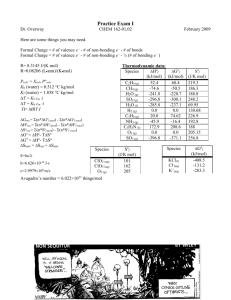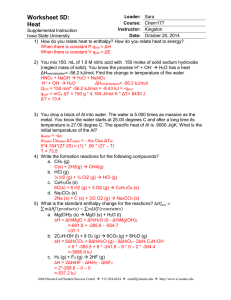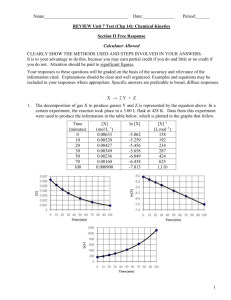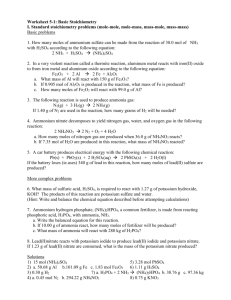CHEM 121 Name_________________________________________ Quiz 7
advertisement
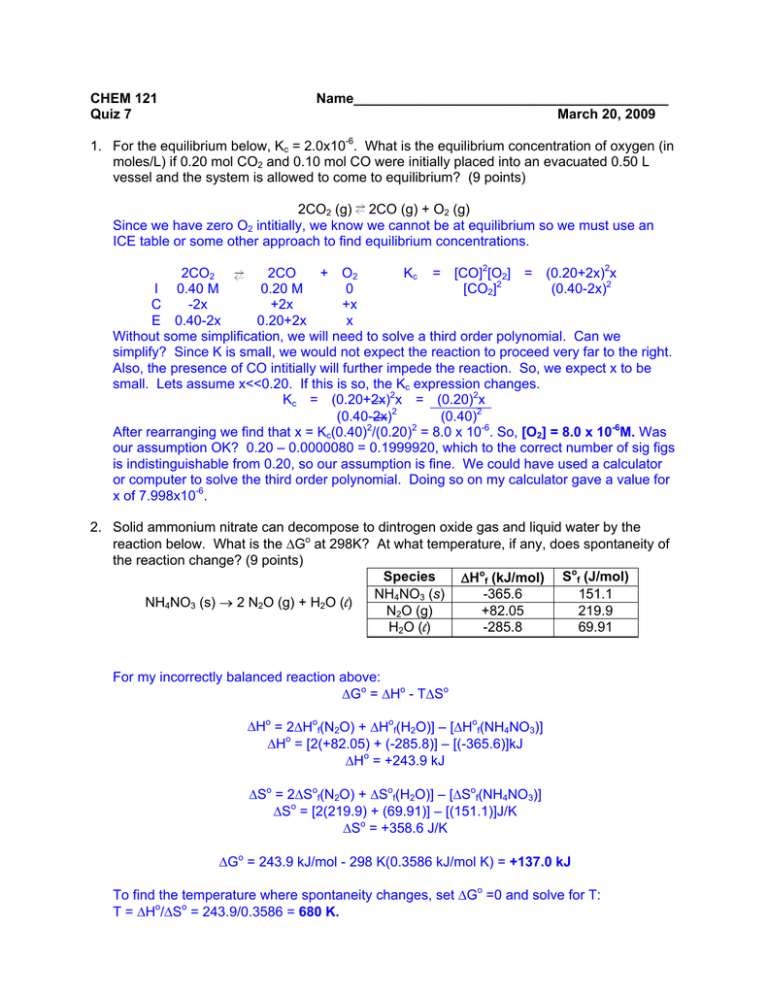
CHEM 121 Quiz 7 Name_________________________________________ March 20, 2009 1. For the equilibrium below, Kc = 2.0x10-6. What is the equilibrium concentration of oxygen (in moles/L) if 0.20 mol CO2 and 0.10 mol CO were initially placed into an evacuated 0.50 L vessel and the system is allowed to come to equilibrium? (9 points) 2CO2 (g) 2CO (g) + O2 (g) Since we have zero O2 intitially, we know we cannot be at equilibrium so we must use an ICE table or some other approach to find equilibrium concentrations. 2CO2 2CO + O2 Kc = [CO]2[O2] = (0.20+2x)2x I 0.40 M 0.20 M 0 [CO2]2 (0.40-2x)2 C -2x +2x +x E 0.40-2x 0.20+2x x Without some simplification, we will need to solve a third order polynomial. Can we simplify? Since K is small, we would not expect the reaction to proceed very far to the right. Also, the presence of CO intitially will further impede the reaction. So, we expect x to be small. Lets assume x<<0.20. If this is so, the Kc expression changes. Kc = (0.20+2x)2x = (0.20)2x (0.40-2x)2 (0.40)2 2 2 After rearranging we find that x = Kc(0.40) /(0.20) = 8.0 x 10-6. So, [O2] = 8.0 x 10-6M. Was our assumption OK? 0.20 – 0.0000080 = 0.1999920, which to the correct number of sig figs is indistinguishable from 0.20, so our assumption is fine. We could have used a calculator or computer to solve the third order polynomial. Doing so on my calculator gave a value for x of 7.998x10-6. 2. Solid ammonium nitrate can decompose to dintrogen oxide gas and liquid water by the reaction below. What is the ∆Go at 298K? At what temperature, if any, does spontaneity of the reaction change? (9 points) o Species ∆Hof (kJ/mol) S f (J/mol) NH4NO3 (s) -365.6 151.1 NH4NO3 (s) → 2 N2O (g) + H2O (l) N2O (g) +82.05 219.9 -285.8 69.91 H2O (l) For my incorrectly balanced reaction above: ∆Go = ∆Ho - T∆So ∆Ho = 2∆Hof(N2O) + ∆Hof(H2O)] – [∆Hof(NH4NO3)] ∆Ho = [2(+82.05) + (-285.8)] – [(-365.6)]kJ ∆Ho = +243.9 kJ ∆So = 2∆Sof(N2O) + ∆Sof(H2O)] – [∆Sof(NH4NO3)] ∆So = [2(219.9) + (69.91)] – [(151.1)]J/K ∆So = +358.6 J/K ∆Go = 243.9 kJ/mol - 298 K(0.3586 kJ/mol K) = +137.0 kJ To find the temperature where spontaneity changes, set ∆Go =0 and solve for T: T = ∆Ho/∆So = 243.9/0.3586 = 680 K. For the correctly balanced reaction: NH4NO3 (s) → N2O (g) + 2 H2O (l) ∆Go = ∆Ho - T∆So ∆Ho = ∆Hof(N2O) + 2∆Hof(H2O)] – [∆Hof(NH4NO3)] ∆Ho = [(+82.05) + 2(-285.8)] – [(-365.6)]kJ ∆Ho = -123.95 kJ ∆So = ∆Sof(N2O) + 2∆Sof(H2O)] – [∆Sof(NH4NO3)] ∆So = [(219.9) + 2(69.91)] – [(151.1)]J/K ∆So = +208.6 J/K ∆Go = -123.95 kJ/mol - 298 K(0.2086 kJ/mol K) = -186.1 kJ Since ∆Ho is negative and ∆So is positive and since ∆Go = ∆Ho - T∆So, there is no temperature where the reaction is nonspontaneous. Since T is always positive, ∆Go = ∆Ho - T∆So will be negative at all temperatures when ∆Ho is negative and ∆So is positive. 3. 25.4 mL of 0.116 M H2SO4 is mixed with 22.4 mL of 0.282 M NaOH. What is the pH of the resulting solution? (7 points) This is a strong acid/strong base reaction. The pH will be determined by what’s left after the acid and base react. H2SO4 + 2NaOH → 2NaCl + 2 H2O 25.4 mL x 0.116 mol H2SO4 x 2 mol NaOH = 5.893 mmol NaOH needed L 1 mol H2SO4 to consume all H2SO4 22.4 mL x 0.282 mol H2SO4 = 6.317 mmol NaOH present L So,H2SO4 is the limting reagent, some NaOH will be left over, how much? (6.319-5.893) = 0.424 mmol This will dissociate completely to give 0.426 mmol of OH- or an [OH] of: 0.424 mmol OH- = 8.870 x 10-3M (25.4+22.4)mL pOH = -log(8.870 x 10-3) = 2.052 pH = 14-pOH = 11.95 Possibly Useful Information ∆G = ∆H - T∆S pH + pOH = 14 o C = K – 273.15 KaKb = Kw x= − b ± b 2 − 4ac 2a Kp = Kc(RT)∆n

